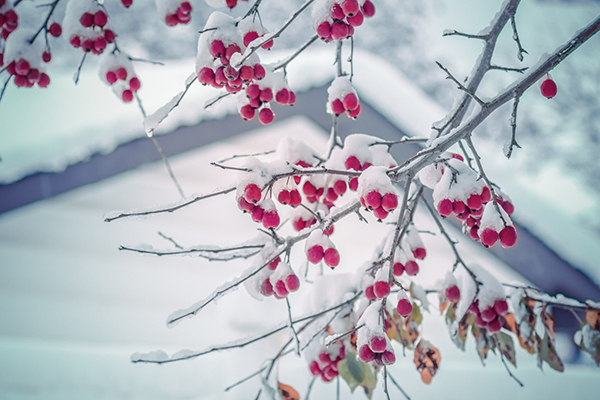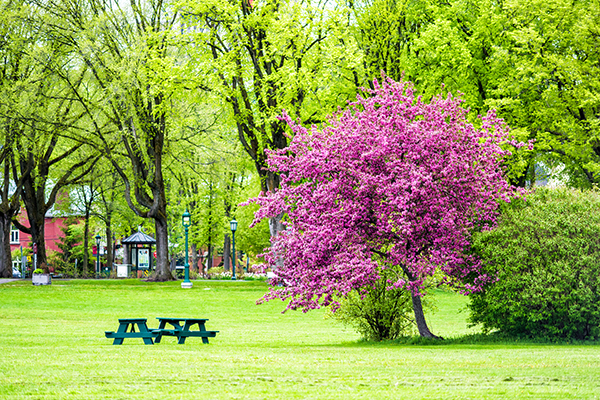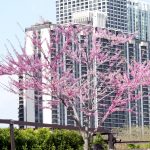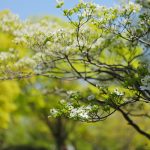It has been a few weeks since our last installment of our series on the native trees of Chicagoland, but we return this week to highlight crabapple trees. Crabapple trees are best known for the fruit they produce which is how they get their name, and their showy spring flowers. These trees and their cultivars are found throughout landscapes in the Chicago area because of their ornamental flowers and their relatively small size which makes them easy to plant in yards and landscapes. There are over 50 different species of crabapple trees (Malus) that are found throughout the northern hemisphere, and only four of these species are found in the United States.

You just might see a striking view in your Crabapple tree such as this Cardinal in your Chicagoland backyard
Crabapple trees are planted mostly for decorative purposes because they are not quite tall enough to be good shade trees. Their brilliant, showy flowers that bloom in the spring give crabapple trees their distinctive look which can enhance the beauty of any landscape. Their flowers can bloom to be red, pink, purple, or white and during the fall, the leaves turn red, making the crabapple one of the most colorful trees in the Chicago area. Crabapple trees are also great for attracting wildlife with their fruit and flowers such as different types of birds and insect pollinators. In this guide, we will further explore the characteristics of native crabapple trees, the natural threats to these trees, and proper crabapple tree care tips.
If you have crabapple trees in your yard in the Chicago area, it is important to take proper care of them to enjoy their beauty. Our professional arborists at Hendricksen Tree Care provide complete tree care services including fertilization, tree trimming, and tree treatment to help keep your crabapple trees strong and healthy.
Characteristics of Crabapple Trees
The most telling characteristics of crabapple trees are their clusters of showy flowers and the crabapple fruits that they produce. The flowers and apples also make these trees very fragrant. Crabapple trees generally grow between 15 and 30 feet tall and there are many cultivars of the crabapple tree that are much smaller and can be planted as shrubs. They are predominantly ornamental plants that are used in yards and landscapes for their natural beauty.

Crabapple trees may be best known for their beautiful flowers that bloom across Chicagoland every Spring
Crabapple trees may be best known for their beautiful flowers that bloom across Chicagoland every Spring
The following are the main characteristics of crabapple trees:
- Height: Crabapple trees grow between 15 and 30 feet and they can be between 20 and 30 feet wide. The canopy is generally round in shape.
- Leaves: The leaves of a crabapple are oval shaped with a slight serrated edge and they grow in an alternate pattern. They are about 3-4 inches long and appear dark green in the growing season before turning to yellow or red in the fall.
- Flowers: The flowers of a crabapple tree bloom in late spring in flowered umbels of 5 or 6. They are fragrant, five-petaled flowers that can appear white, pink, purple or red in color. These flowers are pollinated by insects.
Wildlife such as birds will also enjoy the fruits on your Crabapple trees
- Fruit: The fruit that the crabapple tree produces is what gives it its name. The apples of the crabapple tree ripen in the fall and are usually about an inch in diameter. They have flesh and waxy skin like other types of apples and they are quite fragrant.
- Bark: The bark of a crabapple tree is reddish brown in color with narrow longitudinal scales. Branches start coated in white wool and they eventually become reddish brown with a smooth surface.
Species of Crabapple Trees

Crabapple trees generally stay small and manageable all year round, making them a great tree for your Chicago backyard
Crabapple trees generally stay small and manageable all year round, making them a great tree for your Chicago backyard
As mentioned earlier, there are over 50 species of crabapple trees throughout the world and four of these species are native to the U.S. Of these four species, two of them are native to the Chicago area. The following are the four species of crabapple trees native to the U.S.:
- Pacific Crabapple: The Pacific crabapple (Malus fusca), also known as the Oregon crabapple, can be found in western North America from northern California up to southern Alaska. The flowers of the Pacific crabapple are white or pale pink in color and the fruits are oval shaped and less than an inch in diameter.
- Southern Crabapple: The Southern crabapple (Malus angustifolia) grows throughout the southern and eastern U.S. These trees grow wide and in thickets and the flowers bloom early in the spring. Its flowers are fragrant and pink in color and its leaves grow in red and turn bright green when fully formed. The USDA has put the southern crabapple on the threatened or endangered list of protected plants in certain states.
- American Crabapple: The American crabapple (Malus coronaria), also known as the sweet crabapple, is found in central and eastern North America, including the Chicago area. These trees generally grow between 15 and 25 feet tall and their pink flowers bloom in mid to late spring. The apples of the American crabapple are hard and the color ranges from light green to red.
- Prairie Crabapple: The prairie crabapple (Malus ioensis), also known as the Iowa crabapple, is found in the Midwest including the Chicago area. This tree looks a lot like the American crabapple but with a couple of differences. The leaves of the prairie crabapple have white down on the underside and they have a more pointed shape than those of the American crabapple. Its flowers are white or pink in color and bloom by late spring like the other crabapple species.
Insects and Diseases that Affect Crabapple Trees in Chicago
Crabapple trees, like other types of trees, are susceptible to a variety of pests and diseases that can do it harm. It is important to recognize the symptoms of the most common diseases and insects that threaten these trees:
Disease
- Botryosphaeria Canker: This is a common disease among ornamental trees that damages the branches and leads to branch die back. Affected branches will become wilted and covered with fungal fruiting structures that look like pimples and are dark brown or black in color. Making sure that the tree gets enough water can help prevent this disease.
- Fire Blight: Fire blight is a bacterial disease that attacks fruit trees. This disease can be very destructive as it kills flowers and leaves that remain on the branch after they are dead, and causes twigs and branches to become discolored and curled at the ends. Fire blight can even lead to the formation of oozing cankers that can kill branches and damage the trunk. Effective pruning and fertilization can help make your crabapple trees more resistant to fire blight.
- Apple Scab: Apple scab is a fungal disease that can affect the leaves, branches, and fruit of the crabapple tree. The affected leaves and fruit will have brownish green rough spots on them that can cause the leaves to yellow and fall off prematurely. Trees affected by apple scab need to be treated with a fungicide.
- Apple Rust: Apple rust is a disease caused by several different plant pathogens. This disease starts as yellowish orange spots on the leaves that eventually develop fungal fruiting structures. One of the pathogens that causes this disease comes from the juniper plant so make sure there are no junipers anywhere near your crabapple trees. Apple rust must be treated with a fungicide.
- Frogeye Leafspot: This disease is caused by the same fungus that causes Botryosphaeria canker. The leaves of affected trees will develop small spots with purple margins that will eventually turn gray. Frogeye leafspot will cause the leaves to yellow and fall off the tree. Effective pruning can help control this disease.
Insects
-

Aphids can potentially lay waste to a Crabapple tree if they are left unchecked, but it is best to consult with a professional arborist first
Aphids: Aphids are small, green insects that regularly affect crabapple trees. They feed on young sprouts which can reduce the production of flowers and fruit, and the waste they produce can cause mold to grow on the tree. It is best to consult a professional about using pesticides because some pesticides will also kill the natural predators of the aphid that help keep them in check.
- Japanese Beetles: These beetles cause problems by feeding on the tissue and veins of crabapple leaves, leading to defoliation. It is possible to get rid of Japanese beetles with traps or insecticide, but once again you should consult with professionals before using any insecticide.
-
Mites: Mites can cause damage to crabapple trees if there is a serious infestation. Trees affected by mites will likely produce less flowers and fruit. Insecticides can kill adult mites, but not their eggs which means that insecticide must be applied in cycles to get the hatched mites. You should also consult a professional arborist about dealing with large scale mite infestations.
- Caterpillars: Leafminers and leafrollers feed on the leaves of crabapple trees, but it is rare for them to cause serious damage because natural predators keep them under control. If they do become a problem, they can affect flowering and fruiting.
Crabapple Tree Care Tips
Crabapple trees are much more resistant to the diseases and insects described above if they receive the proper care. These trees are relatively low maintenance and once they have become established, they are drought resistant as well. The following tips will help you provide effective care for your crabapple trees:
- Planting: Crabapple trees do the best in well drained soil in areas where they can get a lot of sun. Exposure to the sun allows the tree to grow a dense canopy that will make it more resistant to diseases. Ask us today about planting a crabapple tree!
- Watering: Young crabapple trees need to be watered regularly in their first year. Established crabapple trees are more drought resistant and only need about one inch of water per week. You should water your crabapple trees during weeks when there is less than an inch of rainfall.
- Mulching: Putting a 2-4 inch layer of mulch around a crabapple tree will help the soil retain moisture for the root system.
- Fertilization: Established crabapple trees only need to be fertilized once per year with a balanced, slow release fertilizer.
- Pruning: Crabapple trees do not need as much pruning as other trees. Pruning a crabapple tree once per year in the winter is best. When pruning a crabapple tree, remove shoots from the base of the trunk, suckers, and dead, damaged, or diseased limbs. If you are not comfortable with pruning your trees, you can have it done by a professional arborist.
Crabapple trees are a common feature of landscapes and properties across the Chicago area because their vibrant leaves and fragrant flowers make them an ideal ornamental tree. The addition of a crabapple tree in your yard will add more natural beauty and its fruit and flowers will attract birds and pollinating insects. Providing excellent care for your crabapple trees will help them live full lives and maintain their stunning beauty.

Crabapple trees are a hearty, standout year-round addition to any residential or commercial landscape in Chicagoland, Illinois
If your crabapple trees are affected by disease or insect infestation, or if they are due for pruning, contact our professional arborists at Hendricksen Tree Care. We are an ISA certified tree service provider that can provide general care and maintenance including tree trimming and fertilization. Our professionals can also accurately diagnose diseases and insect infestations and come up with an effective solution to treat the problem. Hendricksen Tree Care proudly serves northside Chicago neighborhoods as well as north and northwest Chicago suburbs including Arlington Heights, Palatine, Lake Zurich, Northbrook, and Barrington.
Watch out for the next installment in our ongoing series about the native trees of Chicago.















